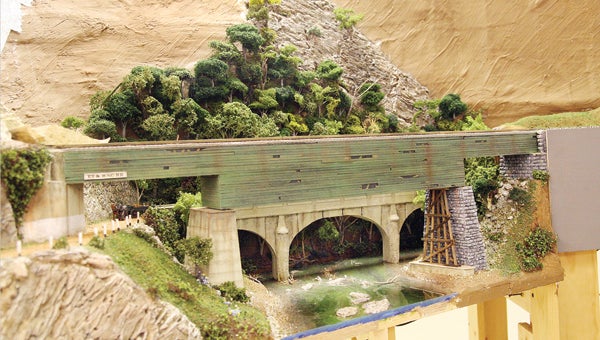Railroad museum tracks changes to rails in Appalachia
Published 8:59 am Monday, December 29, 2014
Photo by Abby Morris-Frye
This section of the Tweetsie exhibit at the George L. Carter Railroad Museum shows the old railroad bridge crossing the Doe River in Hampton. In the background you can see the old highway bridge behind the railroad and a horse-driven cart preparing to pass underneath the tracks.
Nestled away in the center of the campus at East Tennessee State University is a little museum that is home to a lot of history and tradition.
Railroads have always played a major role in the region and the George L. Carter Railroad Museum seeks to preserve that history while introducing visitors to the joys of model railroading.
The museum hosts several examples of model railroads in a variety of scales and gauge sizes Museum Director Dr. Fred Alsop said.
Members of the Mountain Empire Model Railroaders – a local club for railroad enthusiasts – help to design one of the main displays at the museum – a large multi-section of model railroad designed to depict railroads in the south. Club members create their own individual sections which combine together to create the entire line, Alsop said.
“There are basically two guidelines – the sections have to interconnect and they have represent railroads and scenery in southern Appalachia,” Alsop said.
In addition to the large rail line designed by the club, the museum also features other model railroads that have been acquired by the museum.
The museum’s model railroads are operated by volunteers from the Mountain Empire Model Railroaders who provide information about local historic railroads and knowledgeable tips on the basics of model railroading.
But model railroads are not the only things housed at the museums.
The collection also includes railroad memorabilia such as conductors hats, silver service pieces and china from several railroad lines. Lots of old photographs of railroads, trains and stations can also be seen around the museum.
There is also a special room for kids where they can get a hands on feel for trains by constructing their own track or playing in the playhouse built to look like a train caboose.
The kids’ room also features a television where children can watch Thomas the Train.
For Alsop, who has been a professor of biology at ETSU for 43 years, working on the tiny, intricate details while creating a model railroad is therapeutic in a way and gives him a way to express his creative side.
“One of my undergraduate majors was fine arts and the other is biology,” he said. “This gives me a creative outlet for my artistic side which I’ve not had for several years.”
Alsop first became enamored with trains as a child. “As a kid I enjoyed trains,” he said. “Then like most kids, Santa Claus brought me trains on a couple of Christmases.”
But as he grew older, the fascination faded for a while. Then, about 15 years ago, Alsop said he regained his interest in trains, so he joined the Mountain Empire Model Railroaders. It was through the work of the club that he was given the opportunity to work with the museum.
The attention to detail is one of the things that makes the work rewarding for Alsop.
“I enjoy making the scenery more than I do running the trains,” he said. “And besides, somebody has to put all those trees on the mountain side.”
Devoted to the region’s historical ties to railroads, the museum is dedicated to the memory of George L. Carter who built the Clinchfield Railroad through 275 miles of mountainous terrain to carry coal from Eastern Kentucky.
In 1909, when the state’s selection committee visited the area while searching for a site for a proposed teachers college, Carter offered his 120-acre farm and $100,000 toward the establishment of the school, which became ETSU.
The George L. Carter Railroad Museum is open every Saturday, except for holidays, from 10 a.m. until 3 p.m.Admission is free, but donations are welcomed.
The museum is located on the campus of ETSU and can be identified by a flashing railroad crossing signal at the back entrance to the Campus Center Building.
Visitors should enter ETSU’s campus from State of Franklin Road onto Jack Vest Drive and continue east to 176 Ross Drive, adjacent to the flashing RR crossing sign. For more information visit www.etsu.edu/railroad.
For more information on the Mountain Empire Model Railroaders visit www.memrr.org.






